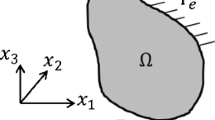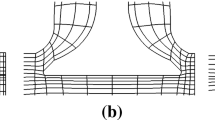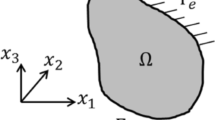Abstract
This paper presents a study and comparison of shape design sensitivity analysis algorithms that are based on the continuum adjoint variable method, the continuum direct differentiation method, and the finite difference method, implemented on a supermini computer with an attached array processor. The basic algorithms and their differences in evaluating shape design sensitivity coefficients are outlined. A solution method for solving a system of equations, using a general sparse storage technique, is used for numerical implementation of shape design sensitivity analysis. It is found that computing shape design sensitivity coefficients using the direct differentiation method is significantly more efficient than using the adjoint variable method or the finite difference method. A detailed performance evaluation of the methods, using an attached array processor, is presented. The performance of the attached array processor, compared to a supermini computer is shown to depend strongly on the type of computations to be carried out. When only parts of a program are running on an attached array processor, the CPU time distribution among the different subroutines of the program can change significantly, compared to using the host processor only.
Similar content being viewed by others
References
Haug, E.J.; Choi, K.K.; Komkov, V. (1986) Design Sensitivity of Structural Systems. New York: Academic Press
Choi, K.K. (1985) Shape design sensitivity analysis of displacement and stress constraints.J. Struct. Mech. 13(1), 27–41
Choi, K.K.; Haug, E.J. (1983) Shape design sensitivity analysis of elastic structures.J. Struct. Mech. 11(2), 231–269
Choi, K.K.; Seong, H.G. (1986) Design component method for sensitivity analysis of built-up structures.J. Struct. Mech. 14(3), 379–399
Choi, K.K.; Seong, H.C. (1986) A domain method for shape design sensitivity analysis of built-up structures. (1986)Comput. Meth. Appl. Mech. Eng. 57(1), 1–15
Prasad, B.; Emerson, J.F. (1982) General capability of design sensitivity for finite element systems. (1982) In23rd Structures, Structural Dynamics, and Material Conference, New Orleans, May 10–12, 175–186
Prasad, B. (1985) An integrated system for optimal structural synthesis and remodelling.Comput. Struct. 20(5), 827–839
Giles, G.L.; Rogers, J.L. (1982) Implementation of structural response sensitivity calculations in a large-scale finite element analysis system.Structures, Structural Dynamics, and Material Conference, New Orleans, May 10–12, 348–359
Haftka, R.T.; Prasad, B. (1979) Programs for analysis and resizing of complex structures (PARS),Comput. Struct. 10, 323–330
Dopker, B.; Choi, K.K. (1987) Sizing and shape design sensitivity analysis using a hybrid finite element code.Finite Elem. Anal. Des.
Yang, R.J.; Choi, K.K. (1985) Accuracy of finite element based design sensitivity analysis.J. Struct. Mech. 13, 223–239
Barthelemy, B.M.; Chon, C.T.; Haftka, R.T. (1986) Accuracy of finite difference approximations to sensitivity derivatives of static structural response.First World Congress on Computational Mechanics, The University of Texas, September
Dopker, B. (1986)Shape design sensitivity analysis of built-up structures including curved components and related topics, Ph.D. thesis, University of Iowa, August
Choi, K.K.; Santos, L.T.; Frederick, M.C. (1985) Implementation of design sensitivity analysis with existing finite element codes. ASME J. Mech. Transm. Autom. Des., 85-DET-77
Santos, J.L.T.; Choi, K.K. (1987) Design sensitivity analysis of nonlinear structural systems with an established finite element code. ANSYS Conference, Newport Beach, CA, March 31-April 3, 1·35–1·56
Wang, S.Y.; Sun, Y.; Gallagher, R.H. (1985) Sensitivity analysis in shape optimization of continuum structure.Comput. Struct. 20, 855–867
Lam, H.L.; Choi, K.K.; Haug, E.J. (1983) A sparse matrix finite element technique for iterative structural optimization.Comput. Struct. 16, 283–295
Sarigul, N.; Maitan, J.; Kamal, H.A. (1982) Solution of nonlinear structural problems using array processors.Comput. Meth. Appl. Mech. Eng. 34, 939–954
Sarigul, N.; Jin, M.; Kolar, R.; Kamal, H.A. (1985) Design of array processor software for nonlinear structural analysis.Comput. Struct. 20(6), 963–974
Technical Manuals—MAP 6430 (1985) Billercia, MA: CSPI Inc.
MAP Application Note,APN 20.1 (1984) Billercia, MA: CSPI Inc., May
Harwell Library Routines, A Catalogue of Subroutines. Computer Science and Systems Division, AERE-R 9185, Harwell, Oxfordshire, 1980.
Luenberger, D.G. (1973) Introduction to Linear and Nonlinear Programming. Reading, MA: Addison Wesley
Author information
Authors and Affiliations
Rights and permissions
About this article
Cite this article
Dopker, B., Choi, K.K. A study of solution algorithms for shape design sensitivity analysis on a supermini computer with an attached array processor. Engineering with Computers 3, 111–119 (1987). https://doi.org/10.1007/BF01206307
Issue Date:
DOI: https://doi.org/10.1007/BF01206307




